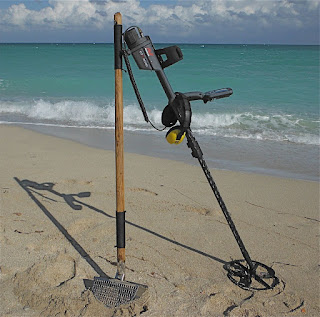I used to get a lot of insults from Excalibur users after posting photos of my CTX 3030 screen with gold on it, now it gives me a warm fuzzy feeling seeing the same people using CTX 3030s and saying its the best thing since sliced bread.
Heck even other metal detecting book authors touting French metal detectors almost broke their ankles jumping on the CTX 3030 bandwagon, welcome aboard guys better late than never !
Here are a few differences between these two superb Minelab beach and water hunting units, differences that may help you decide which waterproof metal detector is best for you.
Depth rating
The Excalibur is rated to 200 feet the CTX 3030 to 10 feet, if you are scuba diving it is obvious which waterproof metal detector is a better fit.
Shallow water hunting the pendulum swings back over towards the CTX 3030, especially when you can see the display screen and take full advantage of target information.
I am sure many people know about CTX 3030 users sealing battery and USB connections to dive deeper with the CTX 3030.
I am sure many people know about CTX 3030 users sealing battery and USB connections to dive deeper with the CTX 3030.
Note to divers, buy an Excalibur and avoid ruining your CTX 3030 and voiding your warrantee.
Search coil and headphone options
Here is where the CTX 3030 user has the upper hand over an Excalibur user, when conditions dictate a change of search coil, you can easily change search coils within minutes.
If you prefer to wear your favorite headphones, you can do so with the CTX 3030.
Those two things can be an advantage for a CTX 3030 user at the beach, a place that is constantly changing.
I am sure many Excalibur users know about Pinpoint mods that allow a user to change search modes quickly or "Inline" connector mods so you can change search coils.
Note to Excalibur users, why spend money voiding your warrantee when you can buy a CTX 3030 change search modes pressing a button and change search coils without worrying about connections.
Note to Excalibur users, why spend money voiding your warrantee when you can buy a CTX 3030 change search modes pressing a button and change search coils without worrying about connections.
Display screen
If you cannot see your CTX 3030 display screen because it is submerged under low visibility water, you are hunting by ear like an Excalibur user.
One of the main advantages to using a CTX 3030 over an Excalibur at the beach, is the amount of target information displayed on the screen.
If you only like shallow water hunting and your screen is under water most of the time, you may be better off using an Excalibur because you are going to have to dig more targets at trashy sites.
Targets you may otherwise have chosen to pass up on scooping if you were able to look at your CTX 3030 screen.
Price tag
The price difference between the two metal detectors is always a factor when deciding between the two metal detectors, especially if you are considering buying accessories.
I will stay on the sidelines on this difference as I have always been lucky enough to have all my metal detectors pay for themselves many times over.
You have to stay within your budget and either of these two waterproof metal detectors is a great investment.
If you only like shallow water hunting and your screen is under water most of the time, you may be better off using an Excalibur because you are going to have to dig more targets at trashy sites.
Targets you may otherwise have chosen to pass up on scooping if you were able to look at your CTX 3030 screen.
Price tag
The price difference between the two metal detectors is always a factor when deciding between the two metal detectors, especially if you are considering buying accessories.
I will stay on the sidelines on this difference as I have always been lucky enough to have all my metal detectors pay for themselves many times over.
You have to stay within your budget and either of these two waterproof metal detectors is a great investment.
These things may help you decide which waterproof Minelab is best for you, but you have another option.
You could do what I do if you can afford to, by owning and using both waterproof Minelabs.
The BBS technology Excalibur has a slower recovery speed and is not as deep as the FBS 2 technology CTX 3030, but you can compensate or overcome both of these cons by using good metal detecting and search techniques.
The CTX 3030 has plenty of bells and whistles that can be of little use when you cannot see the screen, but they can still help if you are not dependent on them and know how to hunt by ear.
One thing I recently picked up on from being around a group of metal detector dealers, is just how many people think it has to be one metal detector or the other.
Why can't you use different horses for different courses if your budget stretches to it, new metal detectors are not always intended to replace other established metal detectors.
In my opinion, they offer new options for a beach or water hunter.
Take a look at the jewelry, coins or artifacts in my beach and water hunting books and you probably cannot tell what metal detector I used to recover them.
In closing, I use an Excalibur like an Excalibur and a CTX 3030 like a CTX 3030.
Two great water proof metal detectors that I love using at the beach.









